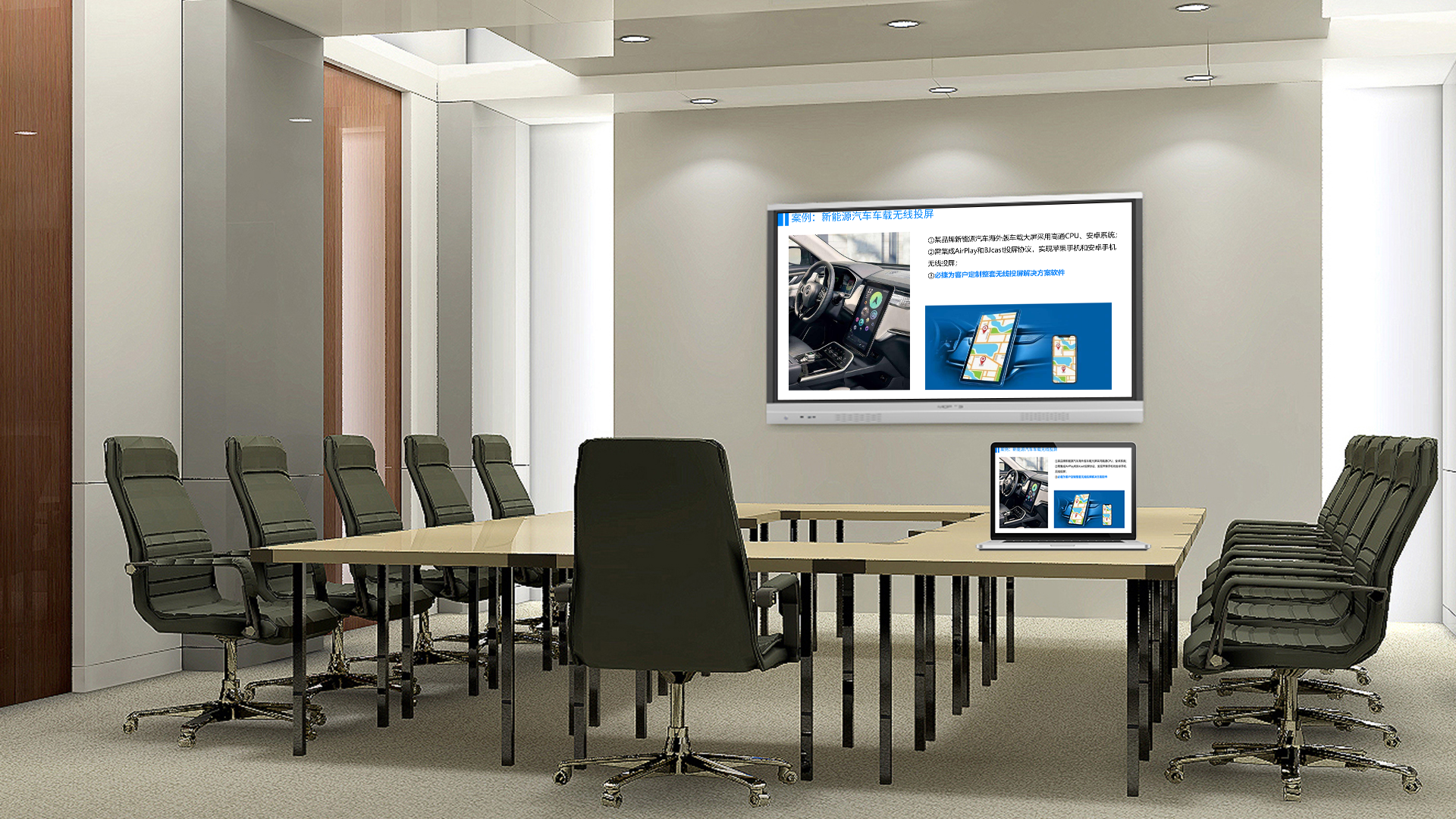Miracast: Wireless Freedom for Android Screen Mirroring
For Android phone and tablet users who want wireless screen mirroring but worry about “needing a network, connection failures, or laggy visuals,” this screen mirroring device is deeply compatible with the Miracast protocol. No WiFi or extra apps required—mirror your Android device to a large screen with one click. It works perfectly for home viewing, office presentations, and daily sharing, completely freeing you from cables, even for beginners.
I. 20-Second Quick Connection: Zero Threshold for Android Users
Fully aligned with Android’s native operating logic—no complex steps to remember:
Device Ready Once Powered On
Plug the screen mirroring receiver into the HDMI port of a TV, meeting screen, or projector. After powering on, the large screen automatically displays a dedicated Miracast name (e.g., “Bedroom Miracast Screen,” “Meeting Room Wireless Cast”). No manual configuration needed; the device enters a ready-to-connect state directly, as simple as pairing Bluetooth.
One Tap on Native Functions
Open your Android device’s “Settings” → “Display” → “Wireless Display” (or pull down the control center and tap “Cast” on some models). Select the large screen name from the device list—connection completes in 1-2 seconds, with real-time screen synchronization. No ads or pop-ups during the process; even the elderly can learn it in one try.
II. Three Core Advantages: Solving Android Mirroring Pain Points
1. Mirror Without a Network: No Scene Restrictions
Unlike network-dependent mirroring methods, Miracast uses “direct device connection” technology. Android devices and the mirroring receiver establish a dedicated wireless connection directly—no WiFi required. Whether you’re camping outdoors (no public WiFi), in a temporary meeting (unstable network), or using an old TV at home (no internet), you can mirror smoothly. Fully free from network reliance, use it anytime, anywhere.
2. Compatible with All Android Devices—Even Older Ones
Perfectly supports Android 4.2 and above, covering mainstream brands like Samsung, Huawei, Xiaomi, OPPO, and vivo (phones and tablets). Compatibility exceeds 98% for both old models (e.g., Huawei Mate 20, Xiaomi 10) and new flagships (e.g., Samsung S24, Xiaomi 14). No need to discard old devices due to model or system version—elderly family members’ Android phones or office tablets can achieve wireless mirroring simply by plugging in the receiver, with maximum compatibility.
3. HD Stable Transmission: Uncompromised Experience
- Clear Details with Sharp Image Quality: Supports 1080P full HD mirroring. When mirroring 4K videos or travel photos taken with your phone, details (such as landscape textures in photos or facial expressions in videos) are sharp, with true-to-life colors—more immersive than small-screen viewing.
- Stable Anti-Interference Transmission: Adopts 2.4GHz+5.8GHz dual-band transmission. Even with interference from Bluetooth devices or router signals, mirroring remains smooth with no lag or motion blur. Latency as low as 15ms ensures responsive operations for short videos or light mobile games (e.g., Honor of Kings), with precise audio-visual synchronization.
- Ultra-Low Disconnection Rate: Daily mirroring disconnection rate is below 0.1%, so home viewing or office presentations won’t be interrupted suddenly. For example, when demonstrating product videos to clients, playback stays smooth throughout—no failures in important occasions.

III. Four High-Frequency Scenarios: Practical & Convenient Mirroring
1. Home Entertainment: Enjoyable Large-Screen Experience
On weekends, lounge on the sofa and mirror streaming apps (e.g., Tencent Video, iQIYI) from your Android phone to the TV via Miracast. The large screen is eye-friendly and more comfortable; after mirroring, you can switch episodes in the background or turn off the phone screen to save power—no need to hold the phone constantly.
For children’s online classes, mirror courses from a tablet to the TV via Miracast. Parents can remotely control pauses or replays via their phones, explaining key content in time to prevent eye strain from prolonged small-screen use.
During family gatherings, relatives take turns mirroring travel photos or children’s growth videos from their Android phones. Automatic slideshow playback and background music from Bluetooth speakers let the whole family gather around the large screen—creating a lively atmosphere.
2. Office Emergencies: Professional Wireless Presentations
If the meeting room computer fails suddenly, use your Android phone to quickly mirror proposal documents or product videos to the meeting screen via Miracast. No need to rush to copy files to a USB drive or rely on the meeting room network—handle emergencies calmly.
When meeting clients outside, use an Android tablet to mirror design drawings or quotes to the large screen via Miracast. Intuitively showcase details (e.g., product dimensions, material descriptions) and avoid the awkwardness of “holding the device for clients to see.” Communication is more professional, and clients understand better.
3. Daily Sharing: Small-Screen Content on the Big Screen
During friend gatherings, take turns mirroring short videos or group photos from Android phones to the TV. The large screen displays content more clearly—no need to pass phones around, creating a more interactive atmosphere.
When picnicking or camping outdoors, connect a tablet to the mirroring receiver and mirror local movies or variety shows to a portable projector via Miracast. No WiFi needed—create a “mobile cinema” anytime, anywhere for a more relaxing leisure time.
4. Elderly Users: Simple Operation with No Pressure
Elderly users can mirror opera or square dance videos from their Android senior phones to the TV via Miracast. No complex operations—just open “Wireless Display” and select the device name. The large screen makes viewing clearer, and operation is simpler than using a USB drive.
When teaching elderly family members to use their phones remotely, mirror your screen via Miracast to demonstrate steps in real time (e.g., sending WeChat messages, checking the weather). Elderly users learn by watching the large screen—easier to understand than listening to voice explanations.
IV. Answers to Common User Questions
Can non-Android devices use Miracast for mirroring?
It mainly supports Android devices, but some Windows 10/11 computers also support Miracast. You can search for the mirroring receiver via the “Connect” option to achieve wireless computer mirroring, meeting multi-device needs.
Can I use my phone for other tasks while mirroring?
It supports “full-screen mirroring”—phone operations (e.g., using WeChat, browsing the web) will sync to the large screen. If you only want to mirror videos, exit mirroring mode: the large screen will continue playing even when the phone screen is off, without affecting use.
What if my old TV has no HDMI port?
Use an HDMI-to-AV converter: connect the mirroring receiver to the converter, then plug it into the TV’s AV port. Ordinary old TVs can be upgraded to Miracast-enabled wireless screens—enjoy wireless convenience without replacing the TV.
V. Two Practical Details: More Worry-Free Use
Portable & Easy to Carry
The mirroring receiver is palm-sized and weighs less than 40g. Tuck it into your phone case or pocket during business trips or travel—no space occupied. No extra charging needed; just plug it into the large screen and power it on—ready to use anytime.
Durable for Long-Term Use
The shell is made of wear-resistant, drop-proof material—no easy damage during daily use. It supports 24/7 continuous mirroring, stable for long-term use in home or office scenarios. No frequent device replacements—high cost-effectiveness.
For Android users, a good Miracast mirroring device should be “no network needed, no apps required, fast connection, stable mirroring.” This device fully aligns with Android ecosystem habits. Whether for daily entertainment, office emergencies, or elderly use, it makes wireless mirroring more free and convenient—truly unlocking the large-screen display value of Android devices.
